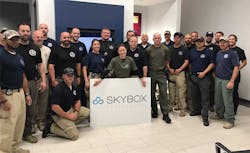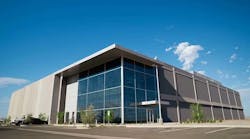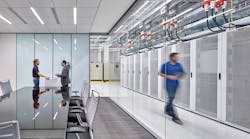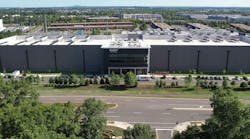Data center professionals live with risk every day. They brainstorm ways to keep their facilities online during any kind of disaster. They seek to engineer solutions for every imaginable threat.
But Hurricane Harvey brought a whole new calculus to disaster risk, slamming the Texas Coast with 125 mile and hour winds and then stalling, drenching parts of the area with more than 50 inches of rain – more than any storm event in American history.
In the midst of calamity, the region’s data center teams secured their facilities and kept their customers online, including services that were vital to the region’s emergency response. There have been no reports of any major Houston data centers experiencing outages.
Houston area data center professionals executed their jobs under pressure. But the key decisions that kept the area’s facilities online were made years ago, during the site selection process. As waters rose beyond the 500-year-flood zones, flooding areas that had never been under threat, Houston’s data centers remained high and dry.
Some facilities were temporarily inaccessible due to water on surrounding access roads. Many providers housed staff on site throughout the crisis. As the waters begin to recede, the data center industry is shifting its attention to how it can help the region recover.
Here’s a look at how each of the Houston area providers managed during Hurricane Harvey:
CyrusOne
CyrusOne is a national chain, but its origins are in Houston, where the company was founded and built its first data center facilities. The company has four data centers in the city, spread across two campuses.
“CyrusOne data centers in Houston have been fortunate to maintain power and have sustained uptime during Hurricane Harvey,” said CEO Gary Wojtaszek. “Our significant investments in backup power systems are made for situations like this, and our data centers are designed to run indefinitely on generator power if required. Houston data centers are staffed around-the-clock and we are grateful for our dedicated employees, many of whom have been away from their families during this trying time.”
The company activated its emergency management and response plan last week, and has made additional office space available for Houston customers in CyrusOne’s Austin, San Antonio, Dallas and Phoenix locations.
“The unprecedented destruction of Harvey is a disaster for the Houston area,” said Wojtaszek. “While our current priority is maintaining availability throughout the storm, CyrusOne is exploring how the company can most immediately support relief efforts and we plan to make a substantial commitment to helping people in Southeast Texas get back on their feet in the days, weeks, and months ahead.”[clickToTweet tweet=”CyrusOne: We plan to make a substantial commitment to helping people in Southeast Texas get back on their feet.” quote=”CyrusOne: We plan to make a substantial commitment to helping people in Southeast Texas get back on their feet.”]
Digital Realty
Digital Realty reported that all its employees and their families in Houston are safe, and the company’s Houston data center facility maintained 100 percent uptime amid the historic rains and flooding brought by Hurricane Harvey.
“Our thoughts and prayers are with the people of Texas throughout this tragic event,” said Digital Realty CEO William Stein. “We are relieved to report that our employees and their families in Houston are safe, and continuing to do whatever it takes to maintain uninterrupted service for the customers who rely on our Houston facility for mission-critical applications. We are proud of the resiliency of our data center designs as well as our operations teams on the ground.”
Digital Realty’s Houston data center facility is located 17 miles north of downtown Houston, outside the FEMA-designated 500-year flood plain. As part of its standard emergency response process, Digital Realty ensures the availability of critical spare parts, diesel fuel and emergency supplies. The company also maintains national contracts with multiple fuel suppliers to provide uninterrupted power in the event of a utility outage.
Digital Realty said it will be making a contribution to the hurricane relief efforts, and will match contributions from Digital Realty employees through the company’s Matching Gifts Program.[clickToTweet tweet=”Digital Realty will contribute to hurricane relief efforts, and match contributions from company employees.” quote=”Digital Realty will contribute to hurricane relief efforts, and match contributions from company employees.”]
Skybox Datacenters
Skybox was mindful of hurricane risk when it launched in Houston in 2014, creating a data center with sturdy infrastructure that included a concrete roof deck that can withstand 190 mile per hour winds. Harvey’s winds never reached that velocity, but the company’s focus on disaster resiliency also extended to its choice of location..
The Skybox Datacenters team in their Houston facility during Hurricane Harvey. (Photo: Skybox)
“Site selection is a major part of our process, and it showed with Harvey,” said Alex Para, the Senior VP of Operations at Skybox. “In selecting our site, we knew the West side of town had great growth and proximity to large customers, but equally important, we are well west of the Addicks Reservoir. Lastly, to ensure our sites performance, we built our roof to Miami Dade specifications, installed ballistics rated glass, and dug in 3x the required water detention.
“Our customers did not have any downtime, our building envelope never took on water nor was compromised in any way, and lastly, due to our proximity directly adjacent to the robust Franz Rd substation, we never once lost utility power or even had a utility power blip.” said Para. “Our hopes and prayers are with all of Houston, its residents, and certainly the other data center operators.”
Para also noted the dedication of the Skybox staff.
“Any data center in any part of the country can get hit with a natural disaster, and the facilities staff risk everything to make sure business continues without interruption,” said Para. “Whether you have outsourced your data center, have it in-house, or a combination of the two, be sure to show appreciation to your mission critical team.”[clickToTweet tweet=”Skybox: Data center facilities staff risk everything to make sure business continues without interruption.” quote=”Skybox: Data center facilities staff risk everything to make sure business continues without interruption.”]
Stream Data Centers
Stream operates a data center in The Woodlands, a northern suburb of Houston.
“Our customers are online and good all-around with no incidence of flooding or loss of utility power,” said Michael Lahoud, Chief Operating Officer & Partner at Stream Data Centers. “The site was accessible throughout the storm, and all team members are safe and accounted for. Our thoughts and prayers are with the people of the Texas Gulf Coast, and we are committing both financial and human resources with the recovery and restoration effort.”
Data Foundry
The Data Foundry Houston 2 data center stayed online throughout Hurricane Harvey. (Photo: Data Foundry)
Austin-based Data Foundry has been operating in Houston since 1996 from a facility in the Marathon Oil Tower, and expanded in a big way when it opened a new campus north of the city in 2013. The company was online throughout Harvey, and provided regular updates to customers on its blog.
“We have not experienced any flooding concerns at either site, and both sites have had 100% uptime,” said Data Foundry CIO Edward Henigin. “Our facilities are stocked with food, water and cots. (Data Foundry’s facilities have) not lost utility power, and we have not had to transition to our back-up generators.
“We greatly appreciate the tireless and vigilant work our data center operations and facilities staff have put in over the last few days,” Henigin added. “Staff has been camped out at our Houston data centers over the past couple of days monitoring the storm 24×7 in our Network Operations Center at Houston 2. We appreciate their vigilance, continuously monitoring network and power statuses.
“More than our data centers’ redundant infrastructure, our staff is what keeps our facilities up and running in times of emergencies. A facility may have the infrastructure, but this means nothing if the right people and the right training for emergency procedures are not in place. Our customers have called and emailed us to show gratitude for their efforts.”[clickToTweet tweet=”Data Foundry: Even more than our data centers’ infrastructure, our staff is what keeps our facilities up & running.” quote=”Data Foundry: Even more than our data centers’ infrastructure, our staff is what keeps our facilities up & running.”]
Equinix
Colocation and interconnection specialist Equinix is the newest arrival to the Houston market, operating one data center acquired from Verizon earlier this year. The Equinix data center remained fully operational and didn’t experience any interruption in service related to Harvey.
“The streets around the site are cleared of flood water and major highways in the area continue to open,” reported an Equinix spokesperson. “However, caution is advised when driving in the area. Customers can (and have) accessed the building. Equinix has staff on-site that can help customers with any issues that could arise from their not being able to make it to the building. To date, this has not been needed.
“Equinix had an on-site team of six personnel in the data center throughout the duration of the storm,” reported an Equinix spokesperson. “The company had prepared in advance of the storm with food, water, sleeping cots and other amenities for the team. They were away from their families and loved ones during the storm, and their dedication has been heroic. On Tuesday, a relief team arrived, giving them some much needed rest.”
The Bunker
Located about 50 miles north of downtown Houston, The Bunker is one of the most unique facilities in the data center business. The multi-building complex was built in 1982 by relatives of Chang Kai Shek, and includes an office building and a 40,000 square foot nuclear bunker, which was converted into an ultra-secure data bunker in 2007. The Bunker added a 105,000 square foot powered shell in 2014.
The Bunker was online throughout the storm, with no utility service outages. The facility is housed on high ground about 345 feet above sea level, making it ideal for disaster recovery, and a number of clients brought staff to the facility to implement business continuity plans.
Netrality Properties
Netrality Properties’ 1301 Fannin Street location in downtown Houston was unscathed by the hurricane. 1301 Fannin was continuously on utility power and the roads surrounding the property are largely unaffected. The property stands ready with 70,000 gallons of fuel onsite which would provide approximately seven days of fuel for the backup generators. In addition, Netrality says it has fuel contracts in place with nearby providers in the event additional fuel is required.
All Netrality employees are safe and accounted for, and throughout the hurricane the site was fully staffed with engineers, electricians, security personnel and senior management with food and supplies to sustain an extended period of support.






